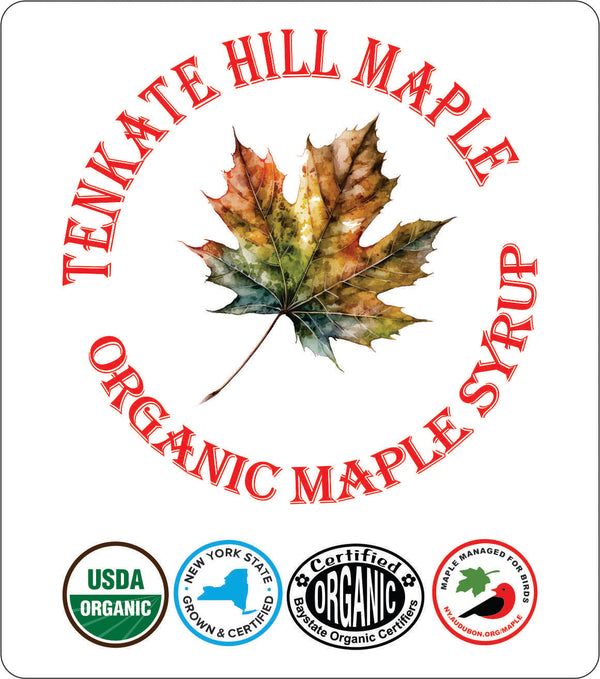About Us
We have been making Maple on a hobby scale since 2010. We started the first year with 5 taps, then quickly changed to 10. The next year we did 20, then over a few years built up to and hovered around 50 with no more trees to tap. In the fall of 2022 we were able to acquire 25 acres behind our existing homestead and upgrade to 150 taps in 2023 and 700 taps in 2024. Also for 2024 we became Organically Certified, Bird Friendly Certified, and New York Grown and Certified! We plan to be around 2,000 taps for the 2025 season. Beyond 2025 we are working on an expansion in collaboration with a neighbor that hopefully will eventually bring us to between 3,000 and 4,000 taps. It is a family and friend business that so far hasn't made any profit but we are having fun doing it!

Tapping in 2013



Boiling in a tent on the back deck in 2013 - the tent didn't stand up well to the wind on the hill!

Getting ready for the first boil our new evaporator in 2014!



Sap collection 2017 through 2019





Our new sugar shack for the 2020 season, so nice to be inside!


It was hard to let go of our trusty old evaporator but we needed upgrade for 2024. This is our new Smoky Lake 2x8 Silverplate. It sure boils a lot of sap compared to the old unit.
A word about our Certifications -

WHAT IS A BIRD-FRIENDLY SUGARBUSH?
While many maple products may look and taste the same, the forests they come from can be managed in different ways. A sugarbush is a forest stand that consists of mostly sugar maple tree species, which can be used to produce maple syrup. Maple syrup can be a model for sustainably produced food that also creates habitat for birds and other wildlife.
Through applied forest management, bird friendly maple producers strive to improve habitat quality in their sugarbushes to optimize breeding and foraging opportunities for forest birds in decline. A bird-friendly sugarbush is managed for the following features to not only provide great habitat for forest birds, but also improve the health of the sugarbush:
- A diversity of tree species and age classes; more than just mature sugar maple
- Complex structural diversity: layers of vegetation; from small seedlings on theforest floor, to saplings and shrubs, to the canopyoverhead
- Standing dead trees and live trees with cavities; the bigger the better
- Large logs and branches on the forest floor
A DELICIOUS CONSERVATION PROJECT
The Bird-Friendly Maple project is a collaborative effort to integrate bird conservation with New York’s maple syrup industry by:
- Promoting sugarbush management practices that support birds, forest health, and sustainable sap production
- Recognizing maple producers for considering bird habitat in their sugarbush
- Increasing awareness of the important role New York’s forests play in bird conservation
- Educating consumers about maple syrup and its many natural benefits.
LOOK FOR THE LABEL!
To recognize and support participating maple producers for their good work, look for maple syrup containers with the label indicating that the syrup is Maple Managed for Birds. Maple producers who intentionally integrate bird habitat into the stewardship of their forest are taking the first step toward ensuring important habitat features are created during sugarbush management activities.

Program Requirements
- Applicability: 100% of maple syrup is sourced from New York maple trees and processed in New York State.
- Food Safety: Certificate of completion of Cornell Cooperative Extension's Maple Food Safety Class OR passing grade (22/25) on the Food Safety Best Practices for Producing Maple Syrup in New York State open book exam and compliance with food safety best practices.
-
Environmental Stewardship: Producer participates in one of the following environmental management programs:
- Every three years, farms are required to participate/renew in the New York State Agricultural Environmental Management (AEM) program, administered by county Soil and Water Conservation districts, with the completion of Tier 2 of the program (or higher). Renewals must be submitted to the Department.

